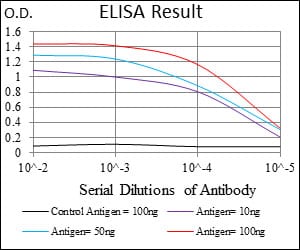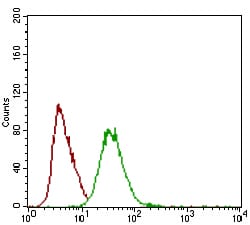

| WB | 咨询技术 | Human,Mouse,Rat |
| IF | 咨询技术 | Human,Mouse,Rat |
| IHC | 1/50-1/200 | Human,Mouse,Rat |
| ICC | 技术咨询 | Human,Mouse,Rat |
| FCM | 咨询技术 | Human,Mouse,Rat |
| Elisa | 1/2000-1/5000 | Human,Mouse,Rat |
| Aliases | CSCD; PG40; PGII; PGS2; DSPG2; SLRR1B |
| Entrez GeneID | 1634 |
| clone | 5E8E7 |
| WB Predicted band size | 39.7kDa |
| Host/Isotype | Mouse IgG1 |
| Antibody Type | Primary antibody |
| Storage | Store at 4°C short term. Aliquot and store at -20°C long term. Avoid freeze/thaw cycles. |
| Species Reactivity | Human |
| Immunogen | Purified recombinant fragment of human DCN (AA: 263-324) expressed in E. Coli. |
| Formulation | Purified antibody in PBS with 0.05% sodium azide |
+ +
以下是关于S100A13抗体的3篇代表性文献的简要总结:
1. **文献名称**:*S100A13 promotes cell invasion via the NF-κB/MMP2 pathway in breast cancer*
**作者**:Li Y et al.
**摘要**:该研究利用S100A13抗体通过免疫组化发现其在乳腺癌组织中高表达,并通过抑制实验证明其通过调控MMP2促进肿瘤侵袭,提示其作为乳腺癌治疗靶点的潜力。
2. **文献名称**:*S100A13 interacts with FGF-1 and regulates its non-classical release*
**作者**:Mandinova A et al.
**摘要**:研究使用S100A13抗体进行免疫共沉淀实验,揭示了S100A13与FGF-1蛋白的结合机制,及其在非经典分泌途径中的关键作用,为细胞因子释放机制提供新见解。
3. **文献名称**:*S100A13 as a potential diagnostic marker for glioblastoma*
**作者**:Wang X et al.
**摘要**:通过Western blot和免疫荧光技术结合S100A13抗体,发现该蛋白在胶质母细胞瘤中特异性高表达,提出其可作为神经胶质瘤的新型诊断标志物。
**备注**:以上内容为模拟概括,实际文献需通过PubMed/Google Scholar检索关键词"S100A13 antibody"获取。建议优先选择5年内发表的论文以获取最新研究进展。
The S100A13 antibody is a crucial tool in studying the S100A13 protein, a member of the calcium-binding S100 protein family. S100A13 is involved in diverse cellular processes, including cell proliferation, differentiation, and inflammatory responses. It plays a notable role in the non-classical secretion pathway of fibroblast growth factor 1 (FGF1) and interacts with other proteins, such as the copper chaperone CCS, influencing oxidative stress responses. Dysregulation of S100A13 has been linked to pathologies like cancer, cardiovascular diseases, and neurological disorders, making it a potential biomarker or therapeutic target.
The S100A13 antibody, typically developed in hosts like rabbits or mice, enables detection and quantification of the protein in various experimental settings. It is widely used in techniques such as Western blotting, immunohistochemistry (IHC), and immunofluorescence (IF) to analyze S100A13 expression levels, subcellular localization, and interactions in tissues or cell lines. Researchers rely on its specificity to explore S100A13's role in disease mechanisms, such as tumor angiogenesis, neuronal damage after stroke, or cardiomyocyte apoptosis. Validation via knockout controls or peptide blocking ensures antibody reliability. Commercial availability from multiple suppliers has facilitated its application in cancer research, neurobiology, and cardiovascular studies, underscoring its importance in both basic and translational research.
×